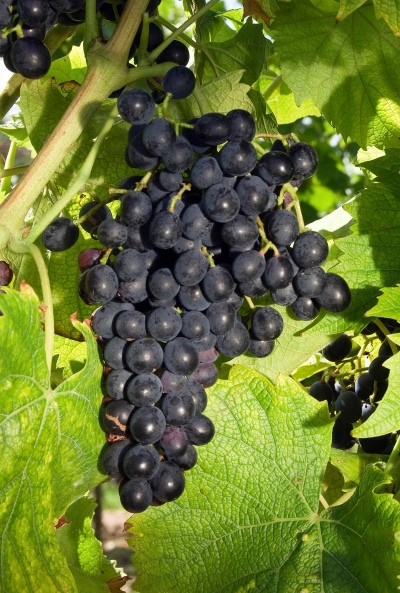
- Authors: State Institute of Viticulture, Freiburg, Germany
- Appointment: dining room
- Berry color: from red to blue-black
- Taste: thin, nutmeg, harmonious
- Ripening period: early
- Frost resistance, ° C: -22
- Name synonyms: FR 550-91 r, Galante
- Flower type: bisexual
- Density of the bunch: loose
- Appeared when crossing: Solaris x Muscat Blau
Galant is a table grape variety. In Russia, it has not yet gained wide popularity, however, gardeners who have tried to grow this variety remain pleasantly surprised by the high-quality harvest, as well as the simplicity of agricultural technology.
Breeding history
Galant was bred at the German State Institute of Viticulture. The variety is the result of a cross between Solaris and Muscat Blau grapes.
Description
The vine is vigorous, forms an average number of stepchildren, ripens well. The leaves are large, dissected, three-lobed, the plate is wavy, the petiole is open, flowering occurs early.
Ripening period
Galant belongs to varieties with an early ripening period: the first berries can be eaten within 120-130 days after flowering.
Bunches
Bunches are cylindrical or branched, loose in density.
Berries
The color of the fruit varies from red to blue-black, the size of the berries is large, the shape is usually round, obtuse-ovoid.
Taste
Taste properties are pleasant, there is a harmonious delicate taste with a hint of nutmeg. Sugar content - 23-25%, acid - 5-7%. The flesh of the berry is dense and crispy. Despite the low percentage of juice yield, a very high-quality wine is obtained from the Galant variety. The drink is dark in color and rich in tannins. When making it, it is important not to overexpose the wort on the pulp, as the skin can impair the taste of the wine.
Yield
Galant belongs to high-yielding varieties.


Growing features
The Galant variety needs classic care, which includes loosening the soil, watering, pruning, garter, fertilizing. Failure to comply with all requirements can lead to thickening, depletion of the plant, and a decrease in yield. This is an early maturing frost-resistant variety that is suitable for growing beginner winegrowers.
Landing
The Galant variety will grow well in a sunny and wind-protected area. A suitable place may be found near the south wall or fence. If there is a slope, it is recommended to plant the tree on a gentle slope. The soil must be well drained.
The planting method usually depends on the type of soil. For example, on sandy soil, it is customary to plant a bush in trenches, and in an area with a close occurrence of groundwater, it is better to plant grapes on ridges.

Pollination
The Galant variety has bisexual flowers, which means that the tree does not need additional pollinating varieties.
Pruning
This is one of the most important stages of growing a crop. So, in preparation for winter, you should cut the vine, leaving a small stump. There are a few more pruning rules:
- treat the cut with an antiseptic or garden varnish to protect against fungi;
- do not be afraid to completely remove non-fruiting shoots: such a tree will not be able to give a normal harvest;
- the Galant variety is recommended to be cut to 10-13 eyes (with a larger number of them, there is a risk of getting small berries and loose bunches);
- for less trauma, turn the cut into the plant;
- if reserve shoots remain in the fall, then in the spring it is better to eliminate the excess.



Top dressing
To help the vine survive the winter, you need to feed it with nutrients that will give it strength. In addition, fertilizers will speed up the ripening of the crop. In late August or early September, the tree can be fed with superphosphate and potassium salt in proportions of 2: 1. Later, re-feeding is required, but in a 1: 1 ratio.
Frost resistance and the need for shelter
This is a fairly frost-resistant variety that can withstand temperatures down to -22 degrees without damaging the central bud.

Diseases and pests
The main enemies of grapes are diseases such as mildew, oidium, gray rot. The Galant variety has high resistance to all these species. To completely prevent damage, the above rules of agricultural technology should be observed.

If a grape is exposed to any disease or insect, this always affects its appearance.
Storage
The presented variety is characterized by a long shelf life, in addition, the bunches tolerate transportation well. This variety is not subject to decay; it can grow raisins on the bushes. At the same time, the resulting raisins have good taste properties reminiscent of prunes.











































































